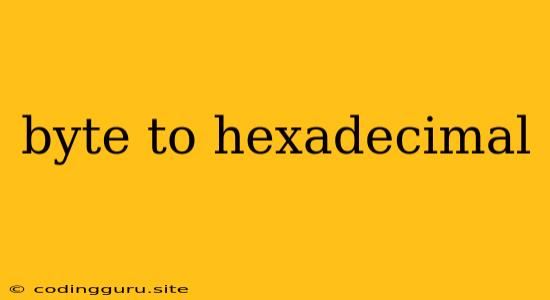Converting Bytes to Hexadecimal: A Comprehensive Guide
In the realm of computer science, data is represented in various formats. One common representation is the byte, which is a unit of data comprising 8 bits. While bytes are the fundamental building blocks of information, they are often displayed or manipulated in hexadecimal format. Hexadecimal, a base-16 numbering system, offers a more compact and human-readable representation of data compared to binary. This article aims to delve into the intricacies of converting bytes to hexadecimal, empowering you to effectively work with data in both formats.
Why Convert Bytes to Hexadecimal?
Before delving into the conversion process, it's essential to understand why converting bytes to hexadecimal is a crucial practice. Here are a few compelling reasons:
- Improved Readability: Hexadecimal offers a more concise and readable way to represent binary data, making it easier for humans to comprehend and analyze. For instance, the binary sequence 10101100 is equivalent to the hexadecimal value "AC," which is much easier to remember and process.
- Efficiency in Data Representation: Hexadecimal requires fewer digits to represent the same amount of data compared to binary. This efficiency streamlines data storage, transmission, and processing.
- Common Usage in Programming and System Administration: Hexadecimal is widely used in programming languages, networking protocols, and system administration tasks. It's a standard format for representing memory addresses, color codes, and other data structures.
Methods for Converting Bytes to Hexadecimal
Now, let's explore the different methods employed for converting bytes to hexadecimal:
1. Manual Conversion
The most basic method involves converting each byte individually. Here's a step-by-step guide:
- Divide the byte into two 4-bit nibbles: Each byte consists of 8 bits. Split the byte into two groups of 4 bits each.
- Convert each nibble to its hexadecimal equivalent: Refer to the table below to convert each 4-bit nibble to its corresponding hexadecimal digit:
| Binary | Hexadecimal |
|---|---|
| 0000 | 0 |
| 0001 | 1 |
| 0010 | 2 |
| 0011 | 3 |
| 0100 | 4 |
| 0101 | 5 |
| 0110 | 6 |
| 0111 | 7 |
| 1000 | 8 |
| 1001 | 9 |
| 1010 | A |
| 1011 | B |
| 1100 | C |
| 1101 | D |
| 1110 | E |
| 1111 | F |
- Concatenate the hexadecimal digits: Combine the two hexadecimal digits obtained from the nibbles to form the final hexadecimal representation of the byte.
Example:
Let's convert the byte 01101001 to hexadecimal:
- Nibbles: 0110 1001
- Hexadecimal Equivalents: 6 9
- Concatenate: 69
Therefore, the hexadecimal representation of the byte 01101001 is "69."
2. Programming Libraries and Functions
Most programming languages provide built-in functions or libraries that simplify the process of converting bytes to hexadecimal. Here are a few examples:
- Python: The
hex()function converts an integer to its hexadecimal representation. - Java: The
Integer.toHexString()method achieves the same conversion. - C++: The
std::hexmanipulator can be used with thestd::coutobject to print hexadecimal values.
These libraries and functions offer a more efficient and convenient way to perform the conversion, especially when dealing with large amounts of data.
3. Online Converters
Numerous online tools are available for converting bytes to hexadecimal. These converters provide a user-friendly interface where you can simply input the byte value and obtain its hexadecimal equivalent.
Illustrative Examples
Let's consider a few practical scenarios where converting bytes to hexadecimal is essential:
- Network Packet Analysis: When analyzing network traffic, packets are often represented in hexadecimal form. This allows for easy identification of packet headers, payload data, and other important information.
- File Editing and Manipulation: Hexadecimal editors provide a way to directly view and modify the raw contents of files at the byte level. This is crucial for tasks like debugging, code analysis, and data recovery.
- Color Representation: In web development and graphics design, colors are commonly expressed as hexadecimal values, such as "#FF0000" for red.
Conclusion
Converting bytes to hexadecimal is an indispensable skill for anyone working with computer data. Whether you're a programmer, system administrator, or data analyst, understanding this conversion process empowers you to effectively analyze, manipulate, and interpret data in different formats. By utilizing the methods and tools discussed in this article, you can seamlessly navigate the world of bytes and hexadecimal, enhancing your data handling capabilities.
